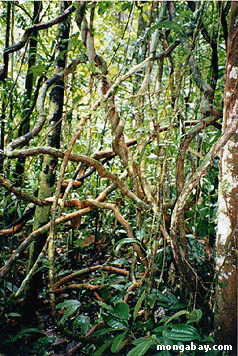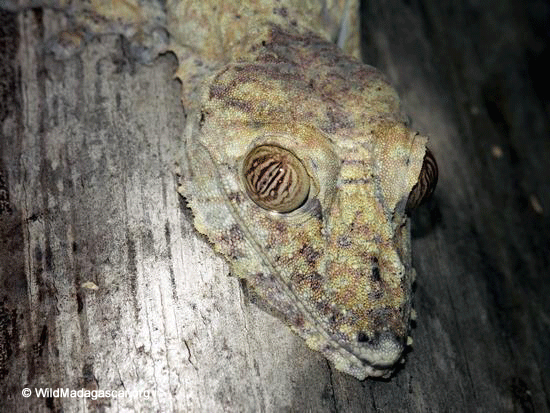VINES AND LIANAS

Climbing Vine, Borneo 1997

A Tangle of Lianas, Peru 1995
In addition to epiphytes, creepers and lianas (woody vines) are present in the canopy leaving vines, hundreds of
feet long, hanging to the floor. There are over 2,500 species of vines from about 90 families. Lianas are vines
that start life on the ground as small (maximum height of about 3 feet-1 m), self-supporting shrubs. In order to
reach the light of the canopy, these shrubs send out tendrils to grab onto sapling trees. As the sapling grows,
the liana clings on and both the tree and the liana reach the canopy together. Since the liana is rooted, it takes
nothing from the tree besides support. The vines spread from tree to tree and their leaves may, in some forests,
make up 40% of the canopy leaves.
Other lianas, known as hemiepiphytes, start life in the canopy as an epiphyte and grow down to the ground. Hemiepiphytes
grow extremely slowly due to dry conditions in the canopy that exist between rainstorms. Once the roots reach the
ground, and the plant is able to tap into the nutrients of the leaf litter, growth rates accelerate.
Some lianas are small, indiscreet vines that grow against the tree, while others are as thick as trees and seem
to hang in the middle of the forest independent of trees. Some of the larger woody lianas may exceed 3000 feet
in length.
Many lianas, like rattan, are climbers equipped with spiked leaf tips that point rearwards so they grip onto tree
saplings with great strength. Rattan is well-known for is use in furniture and ropes. In addition, rattan produces
large, edible fruits - a favorite of primates - and has an edible shoot which is protected by thorns.
Creepers are among the many rainforest species that change their leaf structure as they grow. The plants, especially
those of the Araceae family, start as a shrub on the forest floor and gravitate toward dark objects, usually tree
trunks. When they reach the tree, the climbers grow vertically up the tree pressed tightly against the trunk and
held fast by the triangular flattened leaves. The leaves are positioned in such a way to receive reflected light.
When the vine reaches the upper regions of the forest where there is more direct sunlight, the leaves change so
that they grow away from the tree, several inches long, in order to intercept more direct sunlight.
OTHER PLANT AND ANIMAL RELATIONSHIPS
Canopy trees have coexisted with insects for millions of years and many have developed other unique relationships
in addition to pollination. "Ant-trees" are surprisingly common in the rainforest. In South America,
the Cecropia tree is colonized by Azteca ants. The tree is segmented like bamboo, providing ample compartments
for ant colonization. A queen establishes a nest in one of the hollow chambers, while other cells are inhabited
by workers until entire tree becomes a colony. The workers fend off the plant from all invaders, including insects
and epiphytes, although they will not attack the three-toed sloths which feed exclusively on the leaves of Cecropia.
The plant entices the worker ants to stay and protect it by offering them oil and sugars provided by leaf hairs
and special structures at base of the leaf stem. Other plant species provide food and shelter, while ants provide
protection from pests and epiphytes including the Macaranga tree of Southeast Asia and the Tachi tree of South
America.
Other tree species have mechanisms to prevent burdensome epiphytes which can add so much weight (especially when
full of water after a rainstorm) that they can bring the tree down. The "Naked Indian" tree of South
America and the Crystonia tree of Southeast Asia are among several species of tree that have peeling bark which
prevents epiphytes and creepers from getting a hold or finding a suitable place to start growth. Other species
produce toxins in their bark to ward off infestation by pests and to discourage the growth of epiphytes and lianas.
Lianas are a huge problem for rainforest trees, and numerous species have developed means of discouraging their
growth. Many palm and tree ferns regularly drop frons, while other trees may lose limbs to rid themselves of lianas.
Francis Putz, who studied Panamanian lianas, suggested it may be advantageous for trees to sway out of phase from
their neighbors because this would tend to snap vine connections and kink lianas, cutting off transport systems.
Some lianas have adapted to this mechanism by coiling and bending so they are spring-like and able to better able
absorb the shock.
Review questions:
- What are three types of mimicry?
- Why is completely important?
Continued: Rainforest canopy

Climbing Vine, Borneo 1997

A Tangle of Lianas, Peru 1995












